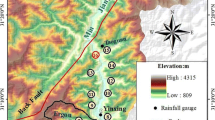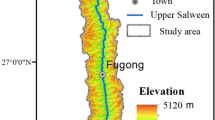Abstract
A large number of debris flows occurred in the Wenchuan earthquake zone after the 12 May 2008 earthquake. The risks posed by these debris flows were rather high. An appropriate model is required to predict the possible runout distance and impacted area. This paper describes a study on the runout characteristics of the debris flows that occurred in the Wenchuan earthquake zone over the past four years. A total of 120 debris flows are analyzed. Separate multivariate regression models are established for the runout distances of hill-slope debris flows and channelized debris flows. The control variables include type of debris flow, debris flow volume, and elevation difference. Comparison of the debris flows occurring before and after the earthquake shows that the runout distance increased after the earthquake due to sufficient material supply and increased mobility of the source materials. In addition, the runout distances of annual debris flow events in 2008, 2010 and 2011 are analyzed and compared. There is a tendency that the runout distance decreases over time due to the decreasing source material volume and possible changes of debris flow type. Comparison between the debris flows in the earthquake zone and the debris flows in Swiss Alps, Canada, Austria, and Japan shows that the former have a smaller mobility.
Similar content being viewed by others
References
Chang DS, Zhang LM, Xu Y, et al. (2011) Field testing of erodibility of two landslide dams triggered by the 12 May Wenchuan earthquake. Landslides 8(3): 321–332.
Chen HX, Zhang LM, Chang DS, et al. (2012) Mechanisms and runout characteristics of the rainfall-triggered debris flow in Xiaojiagou in Sichuan Province, China. Natural Hazards 3: 1037–1057.
Chen JC, Lin CW, Wang LC (2009) Geomorphic characteristics of hillslope and channelized debris flows: a case study in the Shitou area of central Taiwan. Journal of Mountain Science 6: 266–273.
Corominas J (1996) The angle of reach as a mobility index for small and large landslides. Canadian Geotechnical Journal 33: 260–271.
Cui P (2000) The classification of Chinese debris flows. In: Tang BX (ed.), Chinese Debris Flows. Commercial Press, Beijing, pp 60–71. (In Chinese)
Cui P, Hu KH, Zhuang JQ, et al. (2011) Prediction of debris-flow danger area by combining hydrological and inundation simulation methods. Journal of Mountain Science 8: 1–9.
Di BF, Chen NS, Xie WY, et al. (2003) Characteristic analysis of debris flow in Luobajie Gully. Journal of Mountain Science 21: 216–222. (In Chinese)
Hu XW, Lv XP, Huang RQ, et al. (2009) Developmental features and evaluation of blocking dangers of Dashuigou debris flow in Tangjiashan, Beichuan. Chinese Journal of Rock Mechanics and Engineering 28: 850–858. (In Chinese)
Hutchinson JN (1988) General report: Morphological and geotechnical parameters of landslides in relation to geology and hydrogeology. In: Proceedings of the 5th International Symposium on Landslides Held in Rotterdam, Netherland, 10–15 July, 1988, pp 3–36.
Hunter G, Fell R (2003) Travel distance angle for “rapid” landslides in constructed and natural soil slopes. Canadian Geotechnical Journal 40: 1123–1141.
Ikeya H (1989) Debris flow and its countermeasures in Japan. Bulletin International Association of Engineering Geologists 40: 15–33.
Li K, Tang C (2006) Application of prediction model of hazard range about debris flows around Dongchuan zone in Kunming. Journal of Earth Sciences and Environment 28(4): 69–72. (In Chinese)
Liu XL, Lv XJ, Shu PC (2004) Characteristics and hazard assessment of debris flow in Chayuan Gully of Wenchuan County in Sichuan. Journal of Natural Disasters 13: 67–71. (In Chinese).
Liu XL, Li XZ, Su PC (2005) Debris flow process and hazard assessment in Aomiluo Gully of Dechang County, Sichuan. Journal of Catastrophology 20: 78–83. (In Chinese)
Ma C, Hu KH, Cui P, et al. (2012) Empirical approaches to calculating runout distance of hillslope debris flow and channelized debris flow in Wenchuan earthquake zone. Journal of Disaster Prevention and Mitigation Engineering, in press. (In Chinese)
Peng M, Zhang LM (2012) Breaching parameters of landslide dams. Landslides 9: 13–31.
Rickenmann D (1999) Empirical relationships for debris flows. Natural Hazards 19: 47–77.
Rickenmann D (2005) Runout prediction methods. In: Jakob M, Hungr O (eds.), Debris-flow Hazards and Related Phenomena. Springer, Berlin. pp 305–324.
Sassa K, Wang GH (2005) Mechanism of landslide-triggered debris flows: liquefaction phenomena due to the undrained loading of torrent deposits. In: Jakob M, Hungr O (eds.), Debris-flow Hazards and Related Phenomena. Springer, Berlin. pp 81–104.
Su PC, Liu XL, Wang QC, et al. (2004) Debris flow characteristics and hazard evaluation in Qingshan Gully of Danba County, Sichuan. Journal of Geological Hazards and Environment Preservation 15: 9–12. (In Chinese).
Takahashi T (1981) Estimation of potential debris flows and their hazardous zones: soft counter measures for a disaster. Natural Disaster Science 3: 57–89.
Tang C, Zhu J, Ding J, et al. (2011) Catastrophic debris flow triggered by a 14 August 2010 rainfall at the epicenter of the Wenchuan earthquake. Landslides 8: 485–497.
Tang C, Zhu J, Chang M, et al. (2012) An empirical-statistical model for predicting debris-flow runout zones in the Wenchuan earthquake area. Quaternary International 250: 63–73.
Tognacca C, Bezzola GR (1997) Debris-flow initiation by channel-bed failure. In: Proceedings of First International Conference, San Francisco, California, August 7–9, 1997, pp 44–53.
VanDine DF (1985) Debris flows and debris torrents in the southern Canadian Cordillera. Canadian Geotechnical Journal 22: 44–68.
Xu Q, Zhang S, Li WL (2011) Spatial distribution of large-scale landslides induced by the 5.12 Wenchuan Earthquake. Journal of Mountain Science 8(2): 246–260.
Xu Q, Zhang S, Li WL, et al. (2012) The 13 August 2010 catastrophic debris flows after the 2008 Wenchuan earthquake, China. Natural Hazards and Earth System Sciences 12: 201–216.
Xu Y, Zhang LM (2009) Breaching parameters of earth and rockfill dams. Journal of Geotechnical and Geoenvironmental Engineering 135(12): 1957–1970.
Yang ZQ, Liao LP, Yang WK, et al. (2011) Developmental features investigation on Niumiangou debris flow. Journal of Geodesy and Geodynamics 31: 71–74. (In Chinese)
Yu B, Yang YH, Su YC, et al. (2010) Research on the giant debris flow hazards in Zhouqu County, Gansu Province on August 7, 2010. Journal of Engineering Geology 18: 437–444. (In Chinese)
Zhang HH, Ma Y, Zhang JN, et al. (2011a) A study on the formation characteristics of Xiaogou debris flow in Wenchuan earthquake area. Journal of Chengdu University of Technology 38: 42–48. (In Chinese)
Zhang JN, Ma Y, Zhang HH, et al. (2010b) Dagangou debris flow in Dujiangyan after the Wenchuan earthquake, Sichuan. Journal of Mountain Science 28: 623–627. (In Chinese)
Zhang LL, Zhang J, Zhang LM, et al. (2011b) Stability analysis of rainfall-induced slope failures: a review. Geotechnical Engineering, Proceedings of the Institution of Civil Engineers 164(5): 299–316.
Zhang LM, Xu Y, Huang RQ, et al. (2011c) Particle flow and segregation in a giant landslide event triggered by the 2008 Wenchuan earthquake, Sichuan, China. Natural Hazards and Earth System Sciences 11: 1153–1162.
Zhang S, Zhang LM, Peng M, et al. (2012) Assessment of risks of loose landslide deposits formed by the 2008 Wenchuan earthquake. Natural Hazards and Earth System Sciences 12: 1381–1392.
Zhang ZG, Zhang ZM, Zhang SB (2010a) Formation conditions and dynamic features of the debris flow in Bayi Gully in Dujiangyan Country. The Chinese Journal of Geological Hazard and Control 21: 34–38. (In Chinese)
Zhuang JQ, Cui P, Hu KH, et al. (2010) Characteristics of earthquake-triggered landslides and post-earthquake debris flows in Beichuan County. Journal of Mountain Science 7(3): 246–254.
Zimmermann M, Mani P, Gamma P, et al. (1997) Murganggefahr und klimaänderung-ein GIS-basierter ansatz. schlussbericht NFP31, ETH, Zurich. (In German)
Author information
Authors and Affiliations
Corresponding authors
Rights and permissions
About this article
Cite this article
Zhang, S., Zhang, LM., Chen, HX. et al. Changes in runout distances of debris flows over time in the Wenchuan earthquake zone. J. Mt. Sci. 10, 281–292 (2013). https://doi.org/10.1007/s11629-012-2506-y
Received:
Accepted:
Published:
Issue Date:
DOI: https://doi.org/10.1007/s11629-012-2506-y




